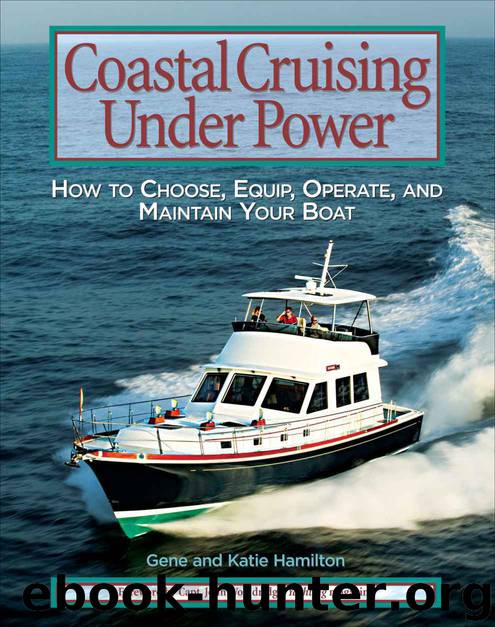Coastal Cruising Under Power: How to Buy, Equip, Operate, and Maintain Your Boat by Gene Hamilton & Katie Hamilton

Author:Gene Hamilton & Katie Hamilton [Hamilton, Gene]
Language: eng
Format: epub
Publisher: McGraw-Hill Education
Published: 2006-04-06T22:00:00+00:00
Prop walk is an important issue on single-screw boats. A right-hand prop will push the stern to starboard when going forward and to port when backing. (Illustration by Christopher Hoyt.)
The props on most twin-screw boats rotate in opposite directions. Therefore, prop walk from one prop is counteracted by the other. (Illustration by Christopher Hoyt.)
The size and location of the rudder also affect the handling characteristics of a boat. Single-screw displacement boats most often have large rudders that steer the boat effectively even when the propeller is not turning (as long as the boat is moving faster than the current). High-speed boats have smaller rudders that are not as effective when the propellers don’t push water past them.
Differences in prop walk and rudder efficiency explain the different handling characteristics of single-screw and twin-screw boats. Of course hull shape, windage, and other factors make each boat unique, but we have found that most single-screw boats share similar basic handling characteristics, as do twin-screw boats. Keep in mind how prop walk affects which way your boat wants to turn, especially in reverse, and pretty soon you will be able to anticipate its movements.
Download
This site does not store any files on its server. We only index and link to content provided by other sites. Please contact the content providers to delete copyright contents if any and email us, we'll remove relevant links or contents immediately.
Breath by James Nestor;(2163)
The River by Peter Heller(2153)
Deep by James Nestor(2087)
Fatal Storm by Rob Mundle(2084)
Sea Survival Handbook by Keith Colwell(2045)
Lonely Planet Australia by Lonely Planet(1974)
Iced In by Chris Turney(1853)
Discover Australia by Lonely Planet(1845)
Lonely Planet Maldives (Travel Guide) by Planet Lonely & Masters Tom(1736)
One Girl One Dream by Dekker Laura(1582)
Looking for a Ship by John McPhee(1577)
Chicken Soup for the Ocean Lover's Soul by Jack Canfield(1554)
Ten Degrees of Reckoning: The True Story of a Family's Love and the Will to Survive by Hester Rumberg(1554)
Lonely Planet Australia (Travel Guide) by Lonely Planet & Lonely Planet(1512)
South with the Sun by Lynne Cox(1463)
The Wave In Pursuit of the Rogues, Freaks and Giants of the Ocean(1431)
Diver Down by Michael Ange(1424)
Marlinspike Sailor's Arts and Crafts by Barbara Merry(1412)
The Golden Rules: 10 Steps to World-Class Excellence in Your Life and Work by Bob Bowman & Charles Butler(1386)
